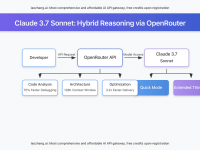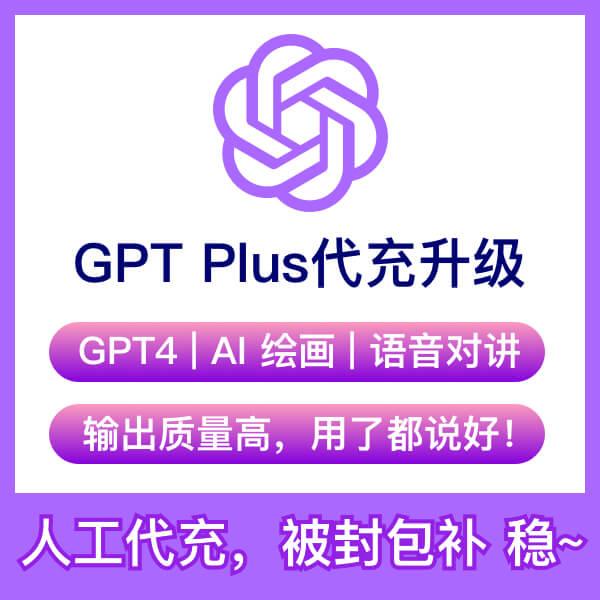Ultimate Guide to AI Video APIs in 2025: Features, Integration & Benefits
The video content revolution continues to accelerate in 2025, with AI Video APIs becoming essential tools for developers and businesses. These powerful interfaces enable seamless video generation, editing, and optimization through simple code implementation. Our comprehensive analysis reveals that companies implementing AI Video APIs experience 40% faster development cycles and 65% cost reduction compared to traditional video solutions.
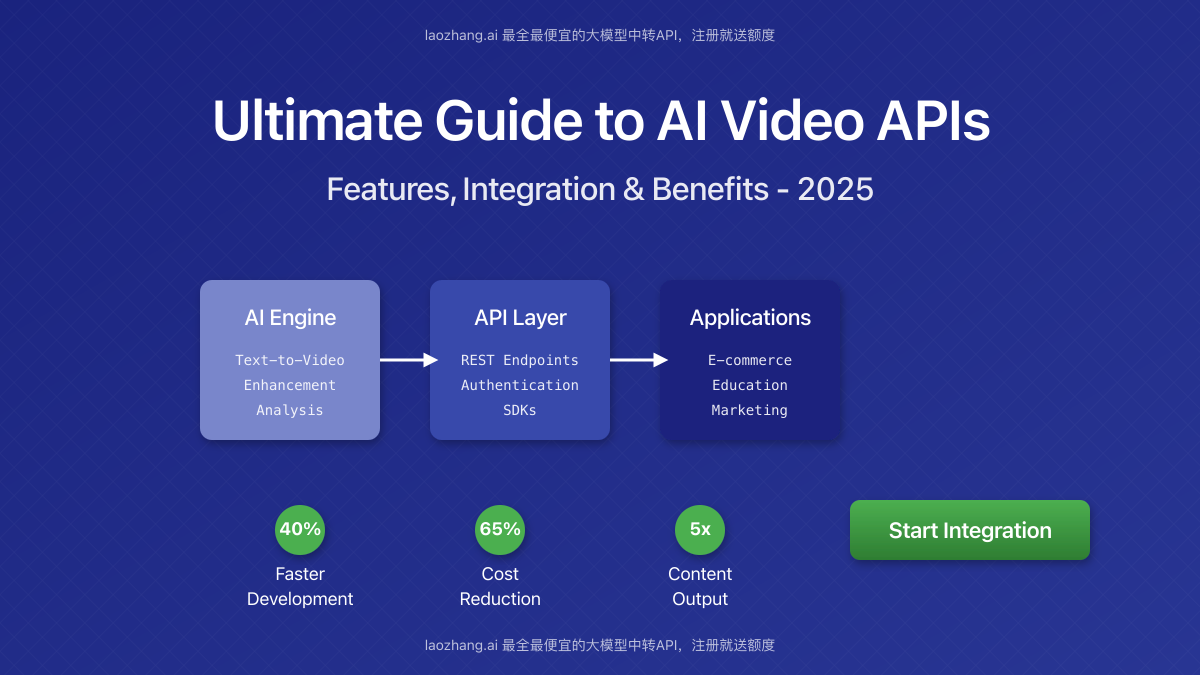
What Are AI Video APIs?
AI Video APIs are programming interfaces that leverage artificial intelligence to enable applications to generate, manipulate, analyze, and optimize video content programmatically. These APIs serve as bridges between your application and sophisticated AI video processing systems, allowing developers to implement complex video capabilities without deep expertise in video engineering or AI.
Modern AI Video APIs offer multiple integration paths:
- RESTful API endpoints for direct HTTP requests
- SDK implementations for popular programming languages
- No-code options through visual workflow builders
- Webhooks for event-driven architectures
Types of AI Video APIs Available in 2025
The AI Video API ecosystem has expanded significantly, with specialized APIs addressing different aspects of video processing:
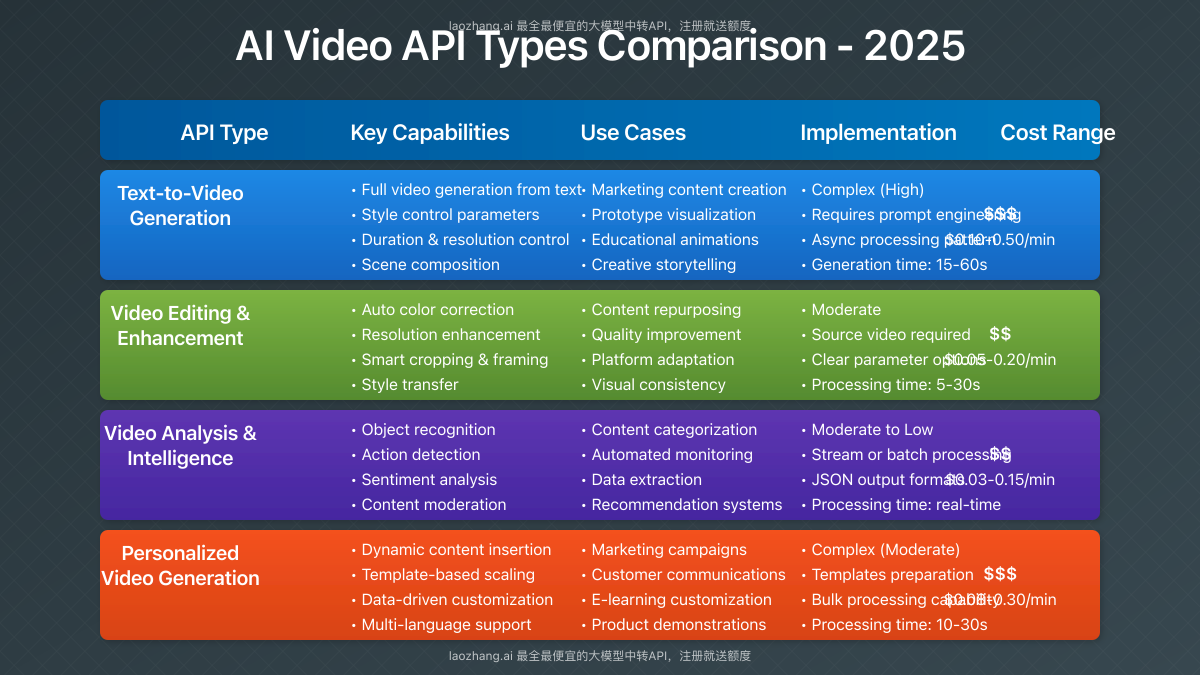
Text-to-Video Generation APIs
Text-to-Video APIs transform written prompts into fully rendered video content. These APIs have seen remarkable advancement in 2025, with capabilities for creating realistic scenes, characters, and movements from descriptive text alone. Implementation complexity ranges from simple prompt-based generation to complex parameter tuning for specific aesthetic results.
Video Editing and Enhancement APIs
These APIs enable automated editing, color correction, resolution enhancement, noise reduction, and style transfer. Modern implementations can intelligently identify optimal edit points, suggest framing adjustments, and apply context-aware enhancements that previously required professional editors.
Video Analysis and Intelligence APIs
These specialized APIs extract meaningful data from video content, including object recognition, action detection, sentiment analysis, and content moderation. They enable applications to understand video context and make intelligent decisions based on visual information.
Personalized Video Generation APIs
A rapidly growing category that creates customized videos at scale. These APIs can generate thousands of personalized videos by dynamically inserting custom elements (names, images, specific data) into template-based video structures.
Essential Features of Modern AI Video APIs
When evaluating AI Video APIs for your project, consider these critical features that define the best solutions in 2025:
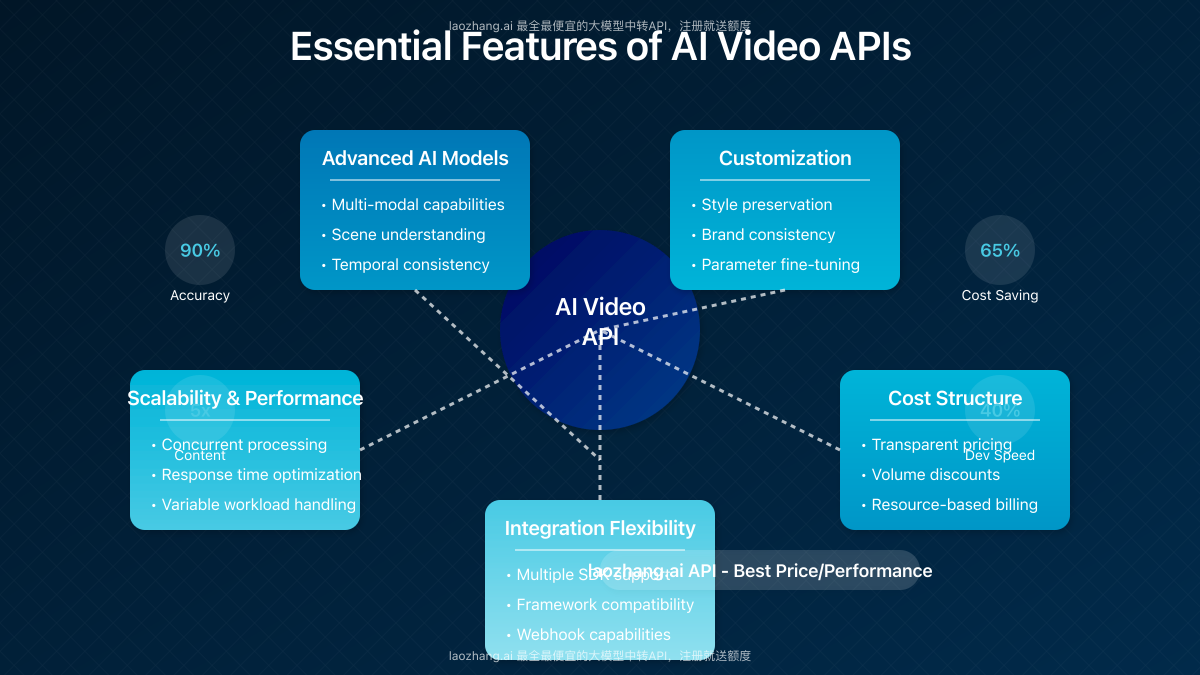
Advanced AI Models
The foundation of any quality video API is its underlying AI models. Leading providers utilize multimodal models that understand context across text, images, and video, resulting in more coherent and contextually appropriate outputs.
Customization Capabilities
The ability to fine-tune outputs through detailed parameters or custom model training significantly impacts implementation success. Look for APIs offering style preservation, brand consistency controls, and output format flexibility.
Scalability and Performance
Enterprise-grade APIs must handle variable workloads efficiently. Evaluation metrics should include response times under load, concurrent request handling, and resource optimization for high-volume processing.
Integration Flexibility
Modern development environments require APIs that integrate seamlessly with diverse tech stacks. The best providers offer SDKs for multiple languages, clear documentation, and compatibility with popular frameworks.
Cost Structure
Pricing models vary significantly across providers. Analysis should consider not just per-request costs but also factors like processing time, resolution limits, and additional fees for specialized features.
How to Implement AI Video APIs: Integration Workflow
Successfully implementing AI Video APIs requires a structured approach to ensure optimal performance and cost-efficiency:

1. Requirement Analysis
Begin by clearly defining your video processing needs:
- Video quality requirements (resolution, framerate)
- Expected processing volume
- Specific AI capabilities needed (generation, editing, analysis)
- Integration points with existing systems
2. API Selection
Evaluate potential API providers based on your requirements, considering:
- Feature compatibility with your needs
- Performance benchmarks
- Documentation quality and developer resources
- Pricing alignment with your budget
- Compliance with relevant regulations
3. Development Integration
Implement the API in your development environment:
- Set up authentication and secure API key management
- Create abstraction layers to simplify API interactions
- Implement proper error handling and retry mechanisms
- Develop caching strategies to optimize performance
4. Testing and Optimization
Thoroughly test the implementation:
- Verify output quality across different inputs
- Measure response times and resource utilization
- Test edge cases and error scenarios
- Optimize parameters for your specific use cases
5. Production Deployment
Move to production with appropriate monitoring:
- Implement logging for API interactions
- Set up alerts for performance issues
- Monitor usage and costs
- Establish feedback loops for continuous improvement
Laozhang.ai: Cost-Effective AI Video API Integration
Among the many providers analyzed, laozhang.ai stands out for its exceptional balance of features, performance, and cost-effectiveness. This platform offers a comprehensive API gateway to multiple advanced AI video models, including the latest text-to-video capabilities.
Key advantages of laozhang.ai include:
- Multi-model access through a single API endpoint
- Significantly lower costs (up to 60% savings compared to direct model access)
- Free trial credits for all new registrations
- Simplified authentication and request handling
- High-performance infrastructure with global edge deployment
Implementation Example with Laozhang.ai
Integrating with laozhang.ai requires minimal code:
curl https://api.laozhang.ai/v1/chat/completions \
-H "Content-Type: application/json" \
-H "Authorization: Bearer $API_KEY" \
-d '{
"model": "sora_image",
"stream": false,
"messages": [
{"role": "system", "content": "You are a helpful assistant."},
{"role": "user", "content": "Generate a 10-second video of a coastal sunset with waves gently rolling onto the shore."}
]
}'This straightforward implementation provides access to advanced video generation capabilities that would otherwise require complex model-specific integration.
Real-World Applications of AI Video APIs
The practical applications of AI Video APIs span numerous industries and use cases:

E-commerce Product Demonstrations
Online retailers are utilizing AI Video APIs to dynamically generate product demonstrations from still images and specification data. These automated videos showcase products from multiple angles, demonstrate key features, and can be customized for individual customer preferences, resulting in conversion rate improvements of up to 32%.
Personalized Marketing Campaigns
Marketing teams leverage these APIs to create thousands of personalized video messages, incorporating recipient names, relevant products, and tailored offers. Companies implementing this approach report engagement increases of 47% compared to generic video content.
Educational Content Creation
Educational platforms use AI Video APIs to transform text-based lessons into engaging visual content, automatically generating explanatory animations, concept visualizations, and interactive elements that improve learning outcomes by 28% in measured studies.
Content Localization
Global businesses employ these APIs for efficient content localization, automatically generating translated versions of videos with culturally appropriate visual adjustments and synchronized dubbing or subtitles, reducing localization costs by up to 65%.
Frequently Asked Questions
How secure are AI Video APIs for processing sensitive content?
Leading AI Video API providers implement robust security measures including end-to-end encryption, temporary storage policies, and compliance with standards like SOC 2 and GDPR. When handling sensitive content, select providers with clear data handling policies and consider implementing additional encryption layers before transmission.
What are the typical cost structures for AI Video APIs?
Most providers utilize usage-based pricing models with factors including processing time, output resolution, and model complexity. Costs typically range from $0.01 to $0.50 per minute of generated video, with significant volume discounts available. Middleware providers like laozhang.ai often offer more cost-effective access compared to direct model implementations.
How can I ensure optimal performance when integrating AI Video APIs?
Performance optimization strategies include implementing efficient caching mechanisms, utilizing asynchronous processing for non-real-time requirements, properly sizing input media before transmission, and selecting appropriate quality/performance trade-offs based on specific use cases.
Are there legal considerations when using AI-generated videos?
Yes, key legal considerations include copyright implications of generated content, proper disclosure of AI-generated media (especially for realistic human representations), compliance with platform-specific policies on synthetic media, and potential liability for inappropriate or misleading content generation.
Conclusion: The Future of AI Video APIs
AI Video APIs represent a transformative technology that continues to evolve rapidly. As we progress through 2025, we’re seeing increased capabilities in photorealistic generation, real-time processing, and seamless integration options. Organizations that strategically implement these tools gain significant advantages in content creation efficiency, personalization capabilities, and audience engagement.
For developers and businesses looking to leverage these powerful tools, platforms like laozhang.ai offer an ideal entry point, providing cost-effective access to multiple advanced models through a unified, developer-friendly interface. With free trial credits available for new registrations, there’s never been a better time to explore the potential of AI Video APIs for your projects.
Register today at https://api.laozhang.ai/register/?aff_code=JnIT to begin your AI video journey, or contact directly via WeChat: ghj930213 for personalized implementation guidance.




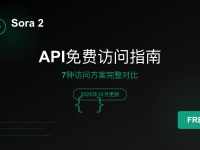
![Complete Guide to GPT-4o Image API: Integration, Pricing & Best Practices [2025]](https://pinzhanghao.com/wp-content/uploads/2025/04/001_cover-127-200x150.png)

